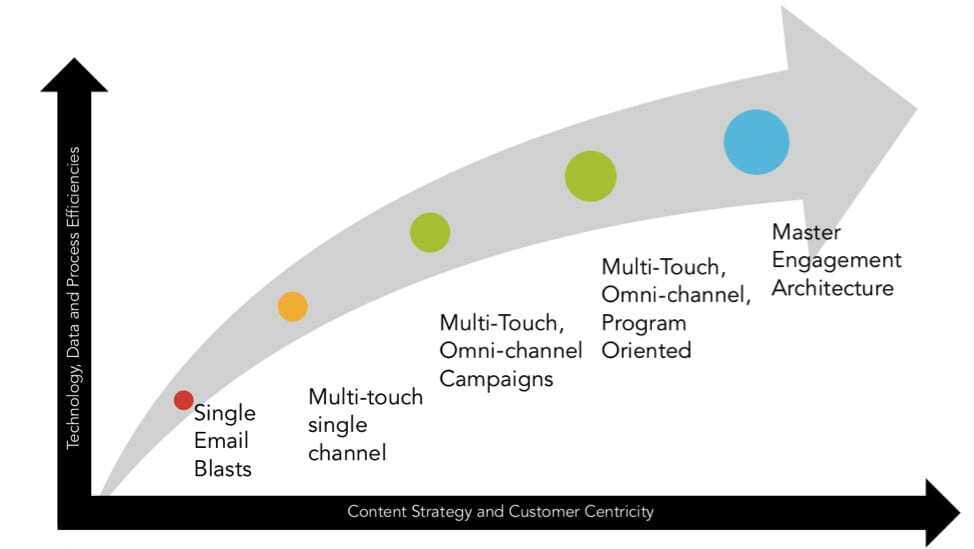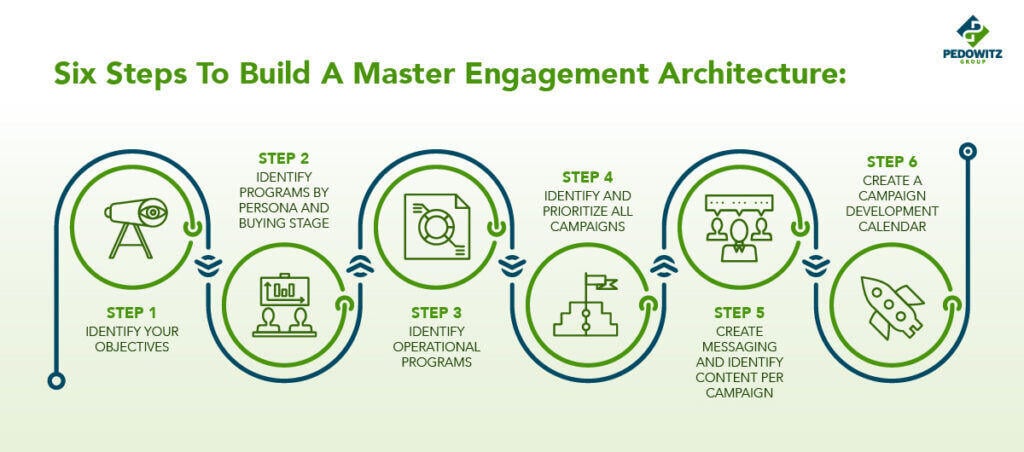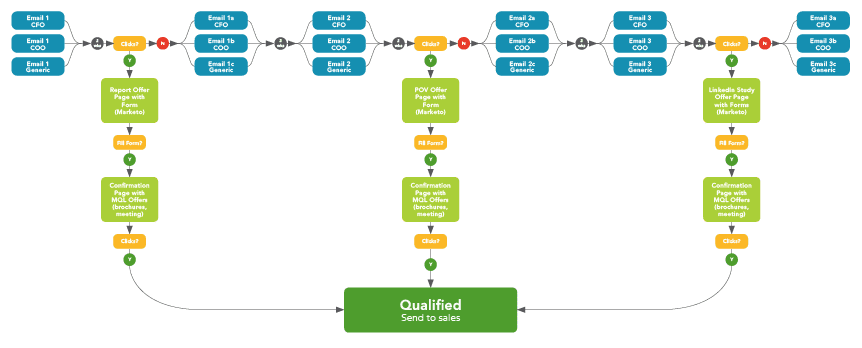As a marketer, campaigns are the most important tools in the demand generation marketer’s toolkit. Campaigns enable us to engage, capture and nurture leads, ultimately translating them into revenue.
Modern marketers understand that today’s customer is smart, and expectations are high for their campaign experience, but how can you enhance the campaign experience to influence results? What is the progression of increasingly sophisticated campaigns and how do we become more proficient at creating them? What’s the path to campaign maturity?
I define a campaign as a series of tactics, delivered through one or more channels, tied to a single theme, one or more offers, and with a specific goal such as engagement, acquisition or nurture. Campaigns feed into larger program initiatives that tie to business objectives and revenue.
Marketing organizations are purchasing marketing automation in droves
In fact, despite widespread adoption, there's still many marketers who don't use it (Source: automateonline). And of those who do, most of them aren't using them to their fullest potential - less than 5% have optimized all the features available to them!
Marketing automation enables personalized campaign experiences across devices and channels, but technology is not the only answer. Most organizations who invest in marketing automation tend to follow a fairly distinctive path to combining technology features with strategic enhancements to their campaigns. Below is a chart that describes that path:

The maturity model is influenced by technology data and process efficiencies as well as content strategy and customer centricity. Balancing both the strategic axis and the technical axis projects marketers into mature campaigns that generate revenue. Marketing automation technology alone doesn’t yield campaign results but is absolutely necessary for success.
The five stages of campaign maturity, explained:
Single email blasts
After marketing automation technology is implemented, most organizations conduct a few single email sends either simply because they have implemented campaigns directly into the marketing automation system they launched previously or they have a deficit of the right content or offers available for customer-centric campaigns.
Multi-touch
Moving from a single touch experience, we see multi-touch, yet single channel initiatives. This campaign typically manifests into a 3- or 4-touch email nurture and may have some rudimentary segmentation. We’ve moved from a single touch to a multi-touch experience. Marketers may stay in this channel for some time as they build their nurturing ecosystem in their marketing automation platform.
Multi-touch, omni-channel
As marketers fill their email nurture campaign “pipeline” they may begin to see results that aren’t as stellar in the single channel. The multi-touch email nurture ecosystem needs a feeder besides segments and lists already in the database. More inbound channels are added to campaign initiatives to fill the top of the funnel and add volume. Channel may be selected to also support persona-specific channel preferences.
Marketers well into this stage will also utilize more platform capability to enhance the campaign experience. For example, customer does “x,” automatically send “y.”
Multi-touch, omni-channel, program-oriented
Multi-touch and omni-channel campaigns can be easily confused with program-oriented initiatives. Just because your campaigns have a number of channels, experiences and paths does not connect those campaigns to a business objective. Many marketers dive into campaign planning without thinking about business objectives that tie to revenue.
Program oriented campaigns are by nature multi-channel and have a very specific business goal. With a common objective, we also start to see an expansion in the Boolean logic in campaign complexity. MAP features and functionality are expanded and users become advanced users in the platform.
Master Engagement Architecture
This is often underutilized!
A Master Engagement Architecture (MEA) is a strategic map of how a company plans to engage their various audiences across integrated tactics to meet their marketing objectives according to their go-to-market strategy. It defines what audiences will be communicated with uniquely vs. collectively and how the company will engage with them in various channels along the buying journey.
Think of an MEA as a collection of programs. Most MEAs take organizations 6+ months to develop in the short term and are leveraged as a foundation for evergreen campaigns with agile campaigns sprinkled on top for time sensitive initiatives.

Step 1: Identify Your Objectives
In my years of working with marketers, I’ve never met a marketer who didn’t have enough to do.
Why?
Too many objectives to meet.
This step is all about prioritizing your objectives from a business perspective and from a marketing perspective. Focusing on what really matters helps guide your foundation for a usable MEA.
Step 2: Identify Programs by Persona and Buying Stage
Objectives help you focus, but we know that true campaign success comes from customer centricity. Your campaigns should be driven by your defined buyer personas and their buying journey:
What are your personas doing at every stage of the buying journey? Are they involved in every step?
Step 3: Identify Operational Programs
Every campaign ecosystem needs operational programs.
- These are sets of campaigns that serve an operational purpose such as securing a double-opt-in, welcoming leads that have just entered your database and obtaining your lead’s preferences.
- You may also have some discovery campaigns to help identify the persona and the buying stage of your leads.
Without this information, your leads may get lost or sent a message that doesn’t resonate with them.
Develop your digital relationship the right way by setting an expectation as to how you will interact with your leads.
Step 4: Identify and Prioritize all Campaigns
By now, you’ve probably identified a ton of campaigns. I’ve had clients who have identified upwards of 200!
In this stage, we will cull down this list by ranking the viability and business impact of a campaign. You may have a campaign that is super easy to develop but has little to no business impact based on your stated objectives. You may also have a campaign that tackles your hairiest objective but may take months to develop content for.
This step may feel like an intense negotiation, but remember, all of these campaigns will eventually be created. You’re only figuring out which to build in the first phase.
Step 5: Create Messaging and Identify Content Per Campaign
In keeping with our mantra of being customer-centric, this stage begins the messaging for each and every campaign. Each touch of your message map should include three elements to truly be customer-centric.
The first should be the pain point as stated by the customer – get inside their head!
The second is your organization’s response to this pain, your main message.
Finally, for every message you provide, you need to back it up with proof. This proof is typically in the form of a content marketing piece to engage and establish trust with your customer. Content that is developed along the buying journey will engage your customers the fastest.
Step 6: Create a Campaign Development Calendar
Our final step may feel familiar. Campaign calendars are nothing new to marketers. What is new, however, is how you think about them. What are the steps needed to develop and optimize a campaign? How do you estimate development such that you are being realistic AND you can achieve your stated objectives?
Strategic planning and priorities listed from steps 1 and 4 will help you develop your calendar. In step 5, you identified all the content needed for your campaigns which will help you figure out which campaigns need longer development time and which campaigns have content that is ready to go.
Remember, your master engagement architecture is a system of campaigns that will be built over time. It can take a year or 2 to install the evergreen campaigns of your master engagement architecture. Be strategic in your development plan and calendar, but also remember that your first phase isn’t the last phase of planning!
Don't Wing Campaign Rollout
I'll now turn it over to our own Kevin Joyce for a different angle.
"What?" I hear you say. "We don’t need more process, red tape, and nonsense slowing us down. Just get out there and execute some campaigns and then optimize."
STOP!
Well, unless you want to invite more faulty campaigns, longer time to market, and annoyed team members.
Now, if your campaign process is quite simple, such as Email > Clicks? > Offer page with form / bot, then maybe you don't need terribly much process.
But most marketers have it far more complex than that - because your customers and prospects have much longer buying journeys. Here's one example:

Multiple avenues, multiple paths of engagement ... and the above is just based on emails alone!
A five-step development process
Need a starting framework? Try this!
Strategy: This is where the program or campaign is proposed and costs / benefits are weighed. Essentially, the team (or approvers) examine the business case for a given campaign, and determine whether to execute on it.
Make sure to identify how to measure its success, as well, so everyone is aligned towards the same goals.
Design: The campaign brief, potentially a creative brief, and ultimately the detailed campaign blueprint are created. While the campaign brief is a simple, one-page document that describes the campaign, the blueprint is the document the marketing operations team works off of.
This includes all details they'll need to build, test, and launch the campaign, and includes all requirements such as A/B testing, timing, utm codes, etc.
Develop: Simply put, this is where everything is put together and thoroughly tested / examined by the team. Make sure a senior resource is involved in the QA process!
In general, I recommend you don't move into the develop stage until the blueprint is complete and all the assets, offers and content are ready. Changing the blueprint (aka the requirements) after development has started will cause rework, slow the campaign down, and increase the risk of errors.
Deploy: Ensure key stakeholders are updated with launch dates, and set everything to go on the assigned date.
Results: Report on key metrics identified in the strategy stage, and make adjustments as necessary.
So, Now What?
Based on the above, how mature is your demand generation organization? What can you do to increase the campaign design capability level of your team? How will it improve your customers' experience?
If you aren't sure, you may need to start with your foundation and focus on mapping the customer journey, then aligning content to it.
As you dive in, knowing the 9 myths of marketing automation and/or seven core components of great lead management will be helpful.
And finally, if you need a helping hand, our Marketing as a Service solution and automation services are the right call!



